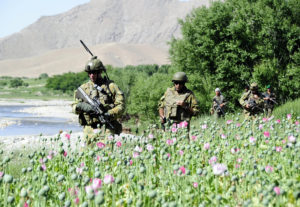Afghanistan’s Opium Production Jumps by 43 Percent
Wikimedia Commons
The United Nations Office on Drugs and Crime released a report on Afghanistan’s opium production on October 23, detailing that opium production has expanded by 43 percent compared to last year. This same report also reveals that eradication efforts, measured by the hectares of poppy fields removed, have fallen 91 percent, from 3,760 hectares removed in 2015 to 355 hectares this year.
Najibullah Noorzai, an Afghan security and drug trade researcher, explained that "international assistance [for counter-narcotics programs] has been reduced; at the same time, rising insecurity in most provinces prevents the government from intervening and doing eradication."
This rising insecurity may be the result of the reduction of NATO troops from 150,000 in 2012 to roughly 12,000 this year, of which around 7,000 are American. Taliban militants have been engaged in a broad offensive that temporarily captured the capital of Helmand province. The rise in opium production could allow for significant extension of the Taliban’s influence.
Helmand represents some 40 percent of the country’s opium production, amounting to over 80,000 hectares – an acreage equal to the next three countries (in terms of cultivated hectares of poppy fields) combined. Afghanistan produces the largest amount of opium in the world and accounts for 90 percent of the world’s heroin.
Much of the Taliban’s wealth comes from opium production, which is derived from ushr, a 10 percent tax sanctioned by Islamic law on all harvests from naturally watered lands. The Taliban, despite their fundamentalist image, turned a blind eye towards opium production. However, this changed in 2001 when the Taliban offered to cut down production in order to receive recognition from the UN.
In the years following the invasion, however, the Taliban permitted the cultivation of poppy fields to resume. Of the profits, $3 billion stay within the country, and an estimated 40 percent of the Taliban’s revenue comes from opium production. Additional wealth is generated from taxes on transportation and charges for assistance in evading authorities.
A majority of the drugs produced in Afghanistan end up in Europe. Nearly 40 percent take a route through either Iran or Turkey before separating into smaller paths across southeastern Europe. Another 24 percent transits the former Soviet states in Central Asia, while the rest reaches markets primarily in Canada and the United States through various ports in Pakistan and India.
As of 2015, the United Nations estimated that 1.6 million drug addicts (5.2 percent of the population) are found in Afghanistan’s cities, with up to 3 million more living in the countryside. Similar rates can be found in other countries along the route, most notably Iran and Pakistan.
Total production and sale of opium and heroin amounts to 13 percent of the country’s legal GDP, meaning that any attempt at eradicating opium production in Afghanistan would have significant economic repercussions.

